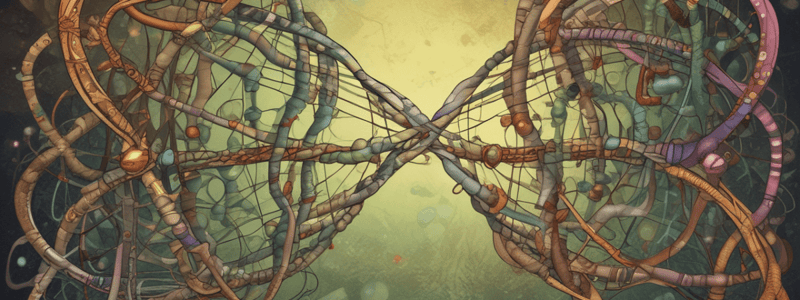Podcast
Questions and Answers
What percentage of DMD female carriers display symptoms of muscle disorder?
What percentage of DMD female carriers display symptoms of muscle disorder?
- 2%
- 8% (correct)
- 10%
- 5%
In DMD female carriers, reduced or absent dystrophin expression is observed.
In DMD female carriers, reduced or absent dystrophin expression is observed.
True (A)
What are the two pseudoautosomal regions (PAR) located on the X and Y chromosomes?
What are the two pseudoautosomal regions (PAR) located on the X and Y chromosomes?
PAR1, PAR2
Which gene subject to XCI shows skewed XCI with preferential inactivation of the pathogenic allele? Duchenne muscular dystrophy (______) carriers have mostly unaffected females with mild symptoms in 8% of carriers.
Which gene subject to XCI shows skewed XCI with preferential inactivation of the pathogenic allele? Duchenne muscular dystrophy (______) carriers have mostly unaffected females with mild symptoms in 8% of carriers.
Match the X-linked disorder with its corresponding X inactivation status:
Match the X-linked disorder with its corresponding X inactivation status:
How many genes are contained in PAR1?
How many genes are contained in PAR1?
Skewed X chromosome inactivation results in a 50:50 ratio of maternal and paternal X alleles being inactivated.
Skewed X chromosome inactivation results in a 50:50 ratio of maternal and paternal X alleles being inactivated.
Female carriers of X-linked disorders may be symptomatic or asymptomatic depending on ___________.
Female carriers of X-linked disorders may be symptomatic or asymptomatic depending on ___________.
Match the following X-linked disorder with its description:
Match the following X-linked disorder with its description:
Flashcards are hidden until you start studying
Study Notes
Irregularities of X-Linked Inheritance
- Pseudoautosomal inheritance is a pattern of inheritance that occurs when genes on the X and Y chromosomes are similar and can exchange genetic material during meiosis.
Pseudoautosomal Regions (PAR)
- PAR1 and PAR2 are homologous regions on the X and Y chromosomes, located on the subtelomeric ends.
- PAR1 is 2.7 Mb on the tips of the short arms and contains 24 genes, including SHOX, which is implicated in disease.
- PAR2 is 330 kb on the tips of the long arms and contains 5 genes.
- During male meiosis, crossover is restricted to PAR, with one obligatory crossover in PAR1, and less frequent in PAR2 (1% of meioses).
- PAR genes exhibit a pseudoautosomal inheritance pattern.
Pseudoautosomal Dominant Inheritance
- Disease-causing alleles on the Y chromosome in affected males, but on the X chromosome in all other affected individuals.
- Individuals with the red asterisk result from X-Y crossover in their father.
- Example: Leri-Weill dyschondrosteosis, a skeletal dysplasia characterized by short stature, abnormal shortening of forearms and lower legs, and misalignment of the wrist.
Male Lethality in X-Linked Pedigrees
- For some X-linked dominant conditions, the absence of a normal allele is lethal before birth.
- Affected male embryos abort spontaneously, and affected newborns are all female.
- Example: Rett Syndrome, a rare neurodevelopmental disorder affecting females, characterized by progressive loss of motor skills and speech.
Female Carriers of X-Linked Disorders
- Female carriers of X-linked disorders may be symptomatic or asymptomatic depending on the inheritance pattern (dominant or recessive) and escape from X chromosome inactivation.
- X chromosome inactivation (XCI) is a dosage compensation mechanism to ensure that X-linked genes are expressed at the same level in females and males.
- Random silencing of one of the two X chromosomes in female somatic cells during early embryogenesis, with the choice maintained throughout mitotic cell divisions.
X Chromosome Inactivation (XCI)
- XCI is an epigenetic mechanism controlled by the X inactivation center (Xic) containing lncRNA genes.
- Initiated by the transcription of Xist from the X chromosome to be inactivated, which coats the entire X chromosome in cis and silences gene expression through epigenetic modification of histones and DNA.
- Xist is controlled by two other lncRNAs transcribed from the opposite DNA strand, one acting negatively (Tsix) and the other positively (Jpx).
Escape from XCI
- 15-25% of X chromosome genes escape inactivation and are expressed from both active and inactive X chromosomes.
- Some genes escape consistently, including all PAR1 genes and some PAR2 genes, while others escape variably, leading to phenotypic variability.
Skewed X Chromosome Inactivation
- Generally, XCI is random, producing a 50:50 ratio of maternal and paternal X alleles inactivated.
- Skewed XCI occurs when inactivation of one X chromosome is favored over the other, leading to an uneven proportion of cells with each chromosome inactivated (deviation from the 50:50 ratio).
Implications for X-Linked Disorders
- For genes subject to XCI, inactivation may be skewed, leading to variable symptoms in female carriers.
- Example: Duchenne muscular dystrophy (DMD), a degenerative myopathy primarily affecting boys, characterized by progressive muscle degeneration and weakness.
- Inheritance is X-linked recessive, with 100% penetrance.
Manifesting Female Carriers
- Most DMD female carriers are asymptomatic, but 8% display symptoms of muscle disorder with variable severity.
- Skeletal muscle biopsy shows reduced or absent dystrophin expression.
- Skewed X-inactivation with preferential silencing of the X bearing the normal DMD gene can lead to manifesting female carriers.
Studying That Suits You
Use AI to generate personalized quizzes and flashcards to suit your learning preferences.




